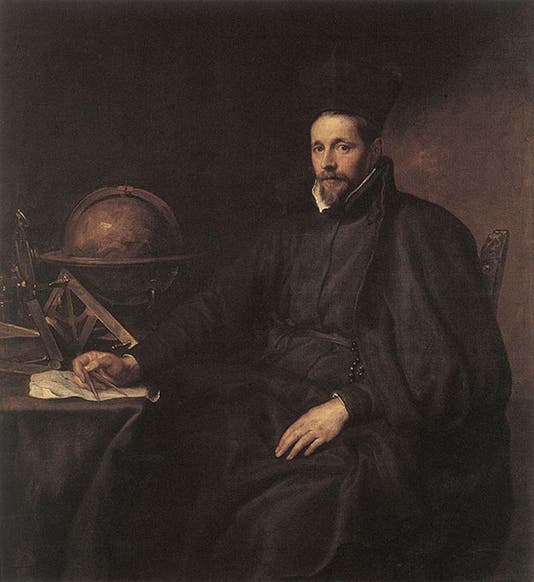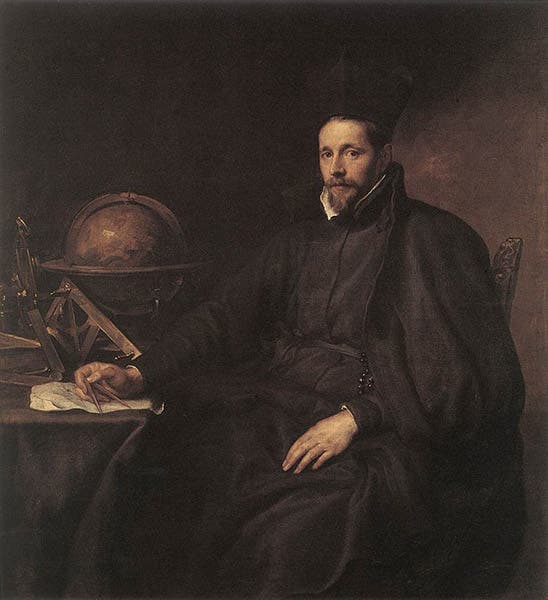Scientist of the Day - Jean-Charles della Faille
Jean-Charles della Faille, a Flemish mathematician, was born Mar. 1, 1597. Della Faille (sometimes de la Faille, and sometimes Joannes) was a Jesuit, one of a large number of Jesuits who pursued astronomy and mathematics in the 17th century. We have an excellent collection of works by Jesuit scientists; indeed, we once (1986) put together an exhibit, Jesuit Science in the Age of Galileo, which featured books by such notable Jesuits scientists as Athanasius Kircher, Christoph Scheiner, François Aguilon, Gaspar Schott, and dozens more, and although it never went online in a proper sense, the printed catalog has been scanned and is available to digitally peruse. We did not include a book by della Faille in our exhibition because we do not own one. He published only one book in his lifetime, a 59-page treatise on finding the centers of gravity of sectors of a circle (Theoremata de centro gravitatis, 1632). It was soon eclipsed by the much larger and more general work by fellow Jesuit, Paul Guldin, with the similar title, De centro gravitatis (1635-41). Still, we should have a copy of della Faille's one publication in our collections. Since I recommended books for acquisition for forty years here at the Library, the blame falls on me. I just never ran across a copy for sale.
Della Faille has attracted a biographer, and the Library does have a copy of Joannes della Faille s.j.: Mathematics, Modesty and Missed Opportunities, by Ad Meskens (Brussels, 2005), where we learn that della Faille studied under the noted Jesuit mathematician Gregorius a Sancto Vincentio in Antwerp, taught in Louvain, and then was transferred by the Society of Jesus to the Spanish court of Phillip IV in Madrid. Meskens tells us that della Faille's one book was admired by non-Jesuit mathematicians such as Christiaan Huygens, but that della Faille had adopted Jesuit vows of modesty to such an extreme that he even tried to recall his book, once he recognized the vanity of putting his name on the title page.
But della Faille does have one claim to fame that the general reader can well appreciate. Just before he was shipped out to Madrid, in 1629 (never to return to the Spanish Netherlands), his family commissioned his portrait from the noted artist, Anthony van Dyck. Van Dyck was already the premier portrait painter of his age, and he would soon become court painter for Charles I in England. As far as I can tell, of the hundreds of portraits made by van Dyck, only one depicts a mathematical scientist, this one of della Faille, and it is a beauty (first image). It shows a surprisingly dashing (he was a Jesuit) young man, with the tools of his trade – a celestial globe and a quadrant – prominently arranged on the table nearby. He is not sporting a van Dyck, but rather a fuller beard. The painting is in the Museum of Fine Arts in Brussels. Van Dyck also painted a portrait of Kenelm Digby, but Digby was more courtier than scientist, and another of Inigo Jones, who was really an architect with archaeological tendencies. We showed both portraits in our posts on these two figures. Neither of the portraits holds a candle to the one van Dyck did of della Faille, which is one of the great portraits of the age.
William B. Ashworth, Jr., Consultant for the History of Science, Linda Hall Library and Associate Professor emeritus, Department of History, University of Missouri-Kansas City. Comments or corrections are welcome; please direct to ashworthw@umkc.edu.







